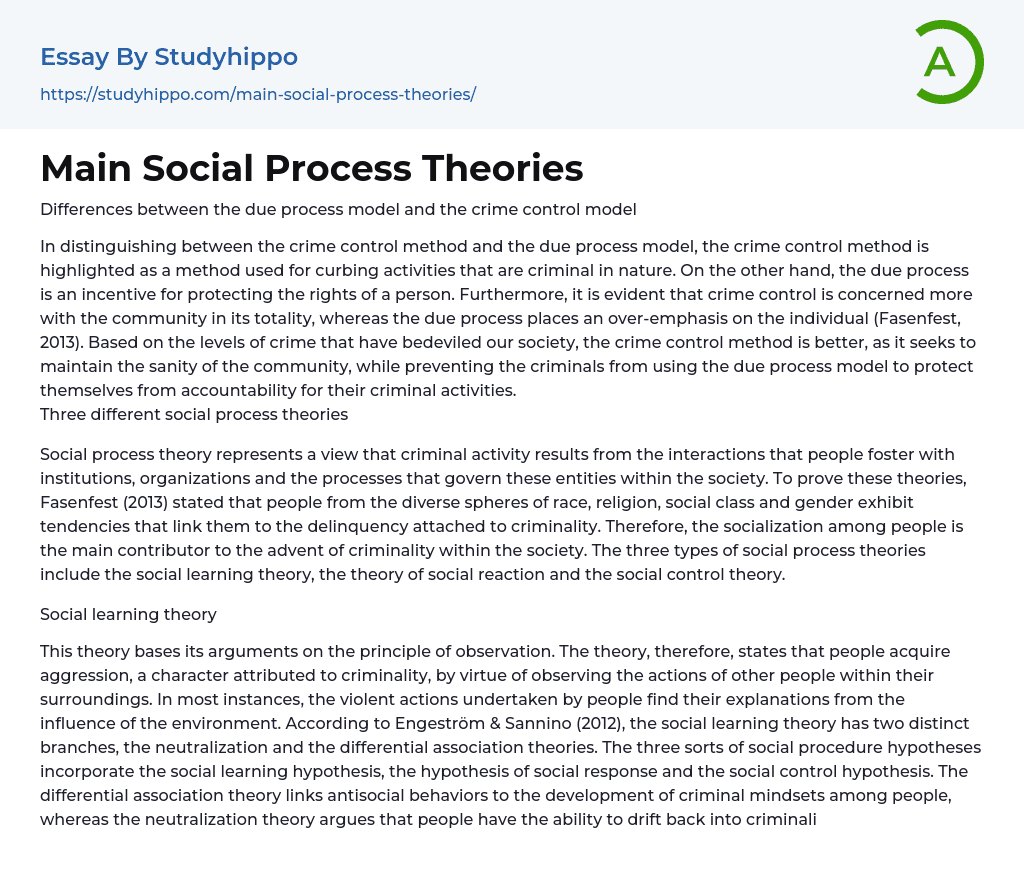Differences between the due process model and the crime control model
The crime control model is centered around reducing criminal activities, while the due process model is designed to safeguard individual rights. Furthermore, the crime control approach places importance on community welfare, whereas the due process focuses on individuals. Taking into account prevailing crime rates in society, the crime control method is deemed more efficient as it prevents criminals from utilizing the due process to avoid responsibility for their deeds (Fasenfest, 2013).
Three social process theories - social learning theory, theory of social reaction, and social control theory - propose that criminal activity is shaped by interactions with institutions, organizations, and societal processes. Fasenfest (2013) argues that individuals from diverse backgrounds in terms of race, religion, social class, and gender display tendencies that contribute to delinquency associated with criminal behavior. Hen
...ce, it can be concluded that the role of socialization plays a crucial part in the emergence of criminality within society.
Social learning theory
The social learning theory is centered on observation, suggesting that people learn aggressive behavior linked to criminality by watching others. This theory highlights the impact of the environment in shaping violent actions. Engestrom & Sannino (2012) identify two branches of this theory: neutralization theory and differential association theory. Additionally, there are three other social process theories: social learning theory, social reaction theory, and social control theory. Differential association theory connects antisocial behaviors with the development of criminal mindsets, while neutralization theory proposes that attitudes and values can cause individuals to revert back to criminal behavior.
The advantages and disadvantages of the Social learning theory
This theory states that criminal activities exist
in various social structures. However, it fails to explain why criminals do not accurately choose their victims, leaving room for the consideration of guilt over their illegal actions.
The Social reaction theory
In contrast to the Social learning theory, the Social reaction theory argues that the label of criminality assigned by society contributes to the development of criminal behavior in certain individuals. To simplify, people labeled as criminals often become criminals by accepting the label, highlighting the society's role in fostering social deviance. Additionally, this theory categorizes deviance as primary or secondary. Primary deviance has short-term effects, whereas secondary social deviance permanently affects an individual's identity.
The Social reaction theory: Pros and cons
This theory examines the reasons why the majority of juvenile offenders continue their criminal behavior into adulthood. However, it falls short in defining the boundaries of criminality, which allows influential individuals to determine what constitutes a crime. Consequently, different levels of subjectivity exist based on an individual's influence in society.
The Social control theory
This theory proposes that the gradual erosion and breakdown of specific societal processes contribute to the development of criminal mindsets. When there are no clear processes in place to define proper behavior, people are more inclined to commit crimes. The theory emphasizes that individuals have a responsibility to follow rules and regulations through self-control and a commitment to compliance.
The advantages and disadvantages of the social control theory
The social control theory incorporates the conscience component to determine self-control, thereby considering the nature of individuals (Engestrom ; Sannino, 2012). According to this theory, individuals with low
self-control are regarded as criminals. However, it fails to recognize the diversity in the nature component, leaving individuals with unique physical and mental challenges susceptible to manipulation. Extensive research reveals that the criminal justice system is primarily influenced by the theory of social reaction. The criminal justice system aims to strengthen the connection between self-image and the promotion of societal sanity by advocating for conformist behavior. Ultimately, the restoration and diversion programs enforced by the criminal justice system mirror the strengths of the Social reaction theory (Fasenfest, 2013).
References
- Engestrom, Y. ; Sannino, A. (2012). Whatever happened to process theories of learning?. Learning, Culture And Social Interaction, 1(1), 45-56. http://dx.doi.org/10.1016/j.lcsi.2012.03.002
- Fasenfest, D. (2013). Engaging social justice (4th ed.). Leiden: Brill.




